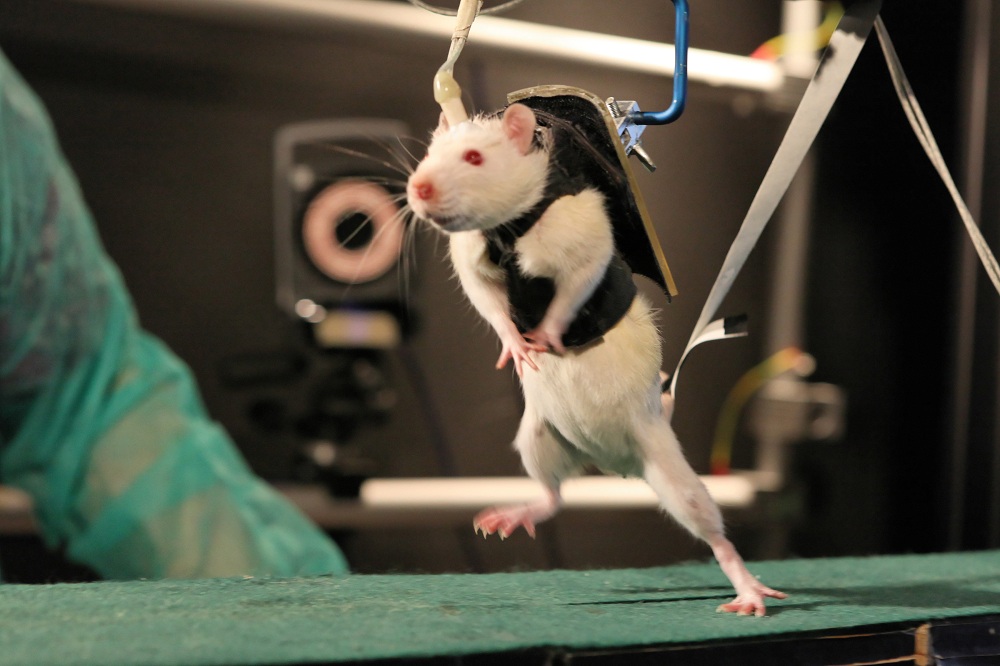Paralyzed Rats Regain Strut In Lab

After severe spinal cord damage, paralyzed rats are able to walk again with the help of a robot to hold them up and stimulate their nerves, a new study shows.
After the rats are trained on the machine for about two months, they gained the ability to control their hind legs — which had previously been cut off from communicating with the brain — with enough dexterity to climb stairs and navigate around objects. This control means that the brain has forged new connections to get around the spinal cord injury.
"We expected they would recover to some degree, but the extent was amazing. They were able to avoid obstacles and walk up stairs," study researcher Janine Heutschi, of the Swiss Federal Institute of Technology in Switzerland, told LiveScience. "Not only that, but the consistency was really amazing. Every single animal we trained in this robot was able to perform these tasks."
What this means for humans is unclear, but the team is working to adapt the procedure for clinical trials.
Paralyzed rats
The researchers simulated spinal cord damage in the rats by making two cuts halfway through the spinal cord; the cuts were two vertebra apart and came from opposite sides, so every nerve of the spinal cord was cut. The paralyzed rats can't use their hind legs, but can get around and act like normal rats using their front limbs.
They let the rats heal for a week, and then started their treatment. They were strapped into a robot that supported them on their rear legs, so they couldn't use their front limbs to propel themselves. The harness held them up without pushing them in any one direction, akin to swimming with a life vest.
Sign up for the Live Science daily newsletter now
Get the world’s most fascinating discoveries delivered straight to your inbox.
"It is complexly passive. It just follows the rat in whatever she does," Heutschi said. "It just supports the body weight and balance; otherwise, they would fall to the side. Whenever the rat wants to walk forward, it has to initiate the movement itself."
The researchers used electricity and injections of neurotransmitters to "fake" a connection between the upper and lower spinal cords while the rats were in the training robot, for 30 minutes six days a week. When they did this, the rat's legs reanimated and moved in a stepping motion involuntarily — the rat's brain couldn't control the movement.The rats then had to learn to control these moving legs. "This can make rats walk in the absence of brain input. It's involuntary, it's completely automatic. There's no way for the rat to steer it. The rat has no control," Heutschi said. "In order for movement to happen voluntarily, their brain has to actively be involved in the task."
Walking again
One day, though, each of the rats hit a "eureka" point, where they realized that their brains were controlling the movement:
"After about two or three weeks of training, there's a moment when the rat realizes that she can start the movement," Heutschi said. "She looks at you like, 'what just happened?' They learn to reproduce this and they get better and better and through this practice these new connections are formed."
From there, the researchers trained the rats to climb stairs and move around obstacles — actions they can't do without the brain getting involved — all within nine weeks. While the rats still need to be supported by the robot, and the spinal cord needs to be stimulated by electricity and drugs, all of the rats learned to walk under their own brainpower and forged connections from the brain to the legs through the cut sections of the spinal cord.
"What we see in the rat is amazing, but what this will mean in humans will have to be seen in clinical trials," Heutschi said, which they are preparing for now.
The study was published today, May 31, in the journal Science.
You can follow LiveScience staff writer Jennifer Welsh on Twitter, on Google+ or on Facebook. Follow LiveScience for the latest in science news and discoveries on Twitter and on Facebook.
Jennifer Welsh is a Connecticut-based science writer and editor and a regular contributor to Live Science. She also has several years of bench work in cancer research and anti-viral drug discovery under her belt. She has previously written for Science News, VerywellHealth, The Scientist, Discover Magazine, WIRED Science, and Business Insider.










